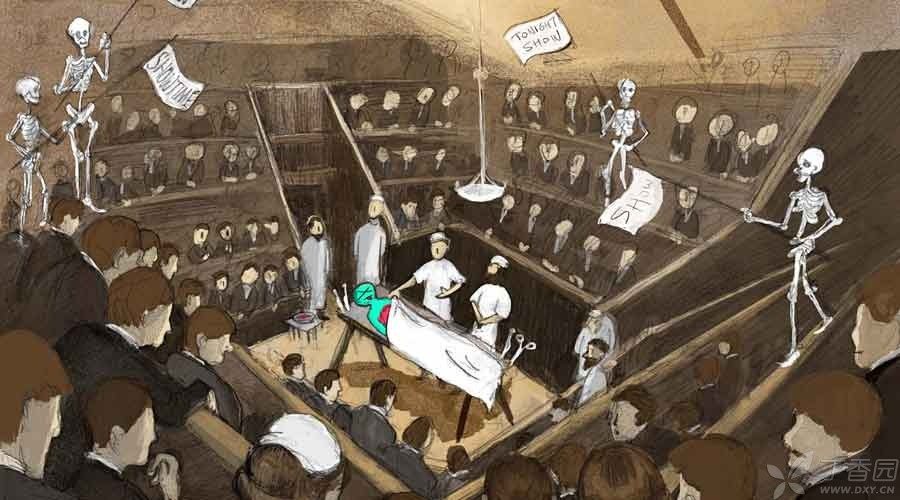
From Bathhouse to Amphitheater: The Embryonic Form of Operating Room You Can’t Imagine
The earliest surgical operations were performed in bathhouses and barbershops, and some were performed in patients’ homes. Of course, the operations at that time could only perform simple surgical diseases such as incision and drainage of body surface infection.
With the development of surgical technology, after the Renaissance, surgeons slowly began to open clinics in Rome and Florence, and gradually explored some more complicated operations such as some superficial and superficial tumor resection.
In the 17th century, some prominent surgeons moved their surgeries to medical schools to complete their surgeries, on the one hand, in order to have a quieter and more orderly environment, and on the other hand, in order to train more surgical talents.
These surgeries are often arranged in the anatomy classrooms of medical schools, which are set up to teach anatomy and are also called amphitheatres. It is very similar to the Italian amphitheatres we have seen in many medieval movies and TV plays, even on a scale.
Today, we can still see the remains of the amphitheater in the anatomy classroom of the medical school, although the scale has been greatly reduced to accommodate only a dozen people, while in the most prosperous era of the amphitheater operating room, the most famous people are likely to accommodate hundreds of people.
Healing or [Killing]: The Crazy Age on the Evolution Road of Operating Room
At that time, due to the lack of anesthesia, hemostasis and anti-infection technologies, every operation was a bloody performance. Skilled and agile surgeons performed their amazing [killing techniques] in an open amphitheater and spread their reputation by doing so!
Surgeons who had their own personal operating rooms and were able to be independent were highly respected and respected in that era. Their fame even exceeded that of any world-class celebrity today.
They operate in their own operating rooms, sometimes attracting hundreds of people! Tickets alone are a very considerable income.
Surgeons often explain while operating in front of the public, and teach their disciples the most exquisite surgical techniques without paying any attention to the patients. In the front row seats, there are often colleagues and teachers who come to watch and cheer, while in the back and further positions are the audience and enthusiastic fans who come to admire fame!
In the blood and pus gushing everywhere, the operation can be completed quickly and well, and the suit cuffs and collar under the leather apron can be kept neat, poised and without any panic. The doctor who presided over the operation is highly sought after by the public, enjoys the highest reputation and wins huge wealth.
According to records, the most famous Scottish surgeon Sam performed an aneurysm resection of the femoral artery in 1860. At that time, the grand occasion was unprecedented. More than 20 senior surgeons and professors sat in the front row and attended the operation. Some also brought their own disciples and interns. There were more than 800 spectators on the stepped round stands. The operation was completed with wonder and praise, accompanied by warm applause for more than 10 minutes.
From Amphitheater to Aseptic Operating Room: Please Remember Another Nobel
This phenomenon lasted for hundreds of years. It was not until the International Surgical Conference held in Berlin in 1887 that a young surgeon Gustav Nobel condemned this phenomenon.
He sharply attacked the operation method: Wooden floors are mixed with sawdust, Mildew and old blood clots, doctors do not even wash their hands before performing surgery, sometimes assistants need to kneel on patients’ limbs to stop their violent twists caused by pain and fear. Another student has to take a basin of phenol and splash it around to treat the blood and pus left behind.
As early as 1883, He set up a conceptually aseptic operating room in his hometown of Kiel in northern Germany. Abandoning the exquisite curtains and baroque window decoration in the traditional operating room, all corners have been changed into circles, impermeable and washable floors have been used, and a system has been established that aseptic surgery and contaminated surgery are no longer in the same operating room.
The young Gustav was too sharp to be tolerated by his elders and the authorities at that time. He never had a chance to speak at a world conference again.
However, the power of truth was so powerful that his ideas were gradually convinced by some advanced American doctors and implemented in the New World of the United States. McBernie of New York and Hausted of Bellevue successively established such operating rooms and spread them throughout the continent and all over the world.
This is the embryonic form of modern operating room. To this day, the design of this operating room is still in use. Even the most advanced integrated laminar flow ward can be said to be the direct descendant of Nobel operating room.
Every surgeon should know and thank such sages as Nobel, McBernie and Hausted. It is these people who broke down the old barriers and started the way of modern surgery. Their achievements will always shine on the monuments of human history.
Author: Yan Qichao
This article is exclusively authorized by the author to be used by Clove Garden and refuses any other form of reprinting.
